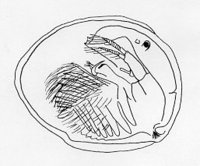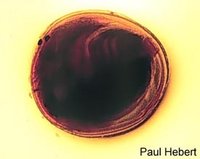
| Palaeos |  |
Branchiopoda |
| Arthropoda | Conchostraca |
| Page Back | Unit Up: Arthropoda | Unit Home | Clade Up: Eucrustacea | Page Next |
| Unit Back: Labrophora | Clade Down: None | Dendrogram | References | Unit Next: Maxillopoda |
|
Abbreviated Dendrogram
CRUSTACEA |--Phosphatocopida `--+--BRANCHIOPODA | |--Anostraca | `--+--Notostraca | `--+--Conchostraca | `--+--Cladocera |?--Xenocarida `--+==Maxillopoda |--Ostracoda `--Malacostraca |
Contents
Overview |
Taxa on This Page
This content on this page copied verbatum from Encyclopedia of Earth - Crustacea under Creative Commons Attribution Share-Alike license. It is intended at some point to add additional material on evolution, paleontology, etc MAK120517
 (Source: Biodiversity Institute of Ontario) |
Conchostracans have the flattened leaf-like legs of branchiopods, but they are completely encased by their carapace. They can usually be found swimming along the bottom amid vegetation.
 (Source: Biodiversity Institute of Ontario) |
Conchostracans are fairly small (2 to 16 mm long) animals, with a carapace that wraps around their entire body. There are two groups of conchostracans that can be divided by their shell morphology; the clam-like conchostracans (Apinicaudata) and the globular conchostracans (Laevicaudata). They can extend their second antennae out of the carapace to swim. The head has a pair of close-set compound eyes that are fused in one genus (Cyclestheria) and 10 to 32 pairs of thoracic legs.
Most conchostracans reproduce sexually, but other species reproduce parthenogenetically. Male conchostracans have specialized hooks on the first and/or second pairs of thoracic legs which grasp the female during mating. The females often swim about with the male holding onto her carapace. Conchostracans hatch from resting eggs as nauplii and don't develop a carapace until their third naupliar stage. As they moult, juveniles become more and more adult-like until they become sexually mature. Species that live in temporary ponds only have one generation per year.
Conchostracans occur in transient ponds throughout much of Canada except the high arctic. They feed on detritus or on plankton by drawing water into the carapace and removing the food particles with their phyllopods.
Some conchostracans look remarkably like a tiny clam - until they start swimming!
| Page Back | Unit Home | Page Top | Page Next |
From "Crustacea", Encyclopedia of Earth. Eds. Cutler J. Cleveland (Washington, D.C.: Environmental Information Coalition, National Council for Science and the Environment) 100219; revised 110529; Creative Commons Attribution Share-Alike